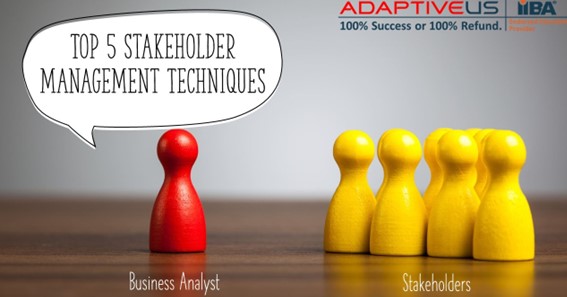Stakeholders are the core of any initiative. No initiative is going to be successful without active stakeholder involvement. Business analysts need to identify and analyze stakeholders affected by a proposed initiative or share a common business need, level of decision-making authority, authority within domain and organization, attitude/ interest towards change, and business analysis work.
Stakeholder Management Technique #1 Stakeholder lists
Brainstorm and interview to generate a stakeholder list. An exhaustive stakeholder list ensures that important stakeholders and groups have not been overlooked. Minimizes risks of missing out requirements.
Since stakeholders are the MOST important source of requirements, it is a best practice to maintain stakeholder register (also known as Stakeholder List). IT Business Analysts MUST identify and list all potential stakeholders for a project. A stakeholder list lists potential stakeholders for IT Business Analysis. Usually, stakeholder identification begins with suggestions made by Sponsor or by Domain SMEs. For a project, there can be large number of stakeholders.
click here – The Crude Oil Traders Gaining High Revenue With bitcoin!
Stakeholder registers should capture:
- Stakeholder name
- Type (Internal / External)
- Category (Primary / Secondary)
- Function / Role
- Designation
- Contact details
- Area and expertise
- Location
- Time availability
- Criticality
- Stakeholder’s objectives
- Expected contribution
- Current contribution
- Interventions needed.
Visit here to know about CBAP course.
Stakeholder Management Technique #2 Stakeholder maps
Stakeholder maps represent relationships of stakeholders to solution and to one another. The 2 common stakeholder maps are Stakeholder matrix and Onion diagram.
Stakeholder matrix: Maps level of stakeholder influence against level of stakeholder interest/impact. 4 quadrants are:
Onion diagram: Levels of stakeholder involvement with solution / project / process.
click here – Hold Accountable: A Detailed Breakdown Of Premises Liability Lawsuits
Stakeholder Management Technique #3 Responsibility (RACI) matrix
RACI is an acronym for Responsible (R), Accountable (A), Consulted (C) and Informed (I). RACI matrix is extremely valuable to document and communicate roles and responsibilities of stakeholders towards various deliverables.
| Responsible | One who performs the task. |
| Accountable | Decision maker and held accountable. |
| Consulted | Stakeholder or stakeholder group asked for opinions, typically SMEs. |
| Informed | Stakeholder or stakeholder group who are informed of tasks. |
Stakeholder Management Technique #4 Personas
Persona is a fictional character that depicts way a typical user interacts with a product. Personas is a powerful technique to keep user perspective while developing or modifying any product features.
Stakeholder Management Technique #5 Stakeholder Charter
The stakeholder charter is a tool used by organizations to ensure that all stakeholders’ interests and needs are considered when making strategic decisions. The charter provides a framework for analyzing and incorporating the perspectives of all stakeholders into decision-making processes. It is important to note that the stakeholder charter is not a static document; rather, it should be updated on a regular basis to reflect changes in the organization’s stakeholder landscape.
Usefulness of Stakeholder Management Techniques
- Identifies stakeholders for business analysis.
- Helps to engage all stakeholder groups.
- Assist in analyzing stakeholders and their characteristics.
Limitations of Stakeholder Management Techniques
- Influence and interest assessment can be complex and risky.
- Some may not feel the need for it in ongoing projects.
About Adaptive US
Adaptive US is world’s Go to Provider of IIBA Certifications Training (CBAP, CCBA, ECBA, CBDA, AAC, CPOA, and CCA) and Study Aids. Get 100% Success or 100% Refund guarantee for all IIBA certifications Training. Adaptive US provided business analyst training, templates, tools for it’s clients throughout the world.






